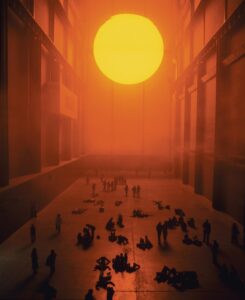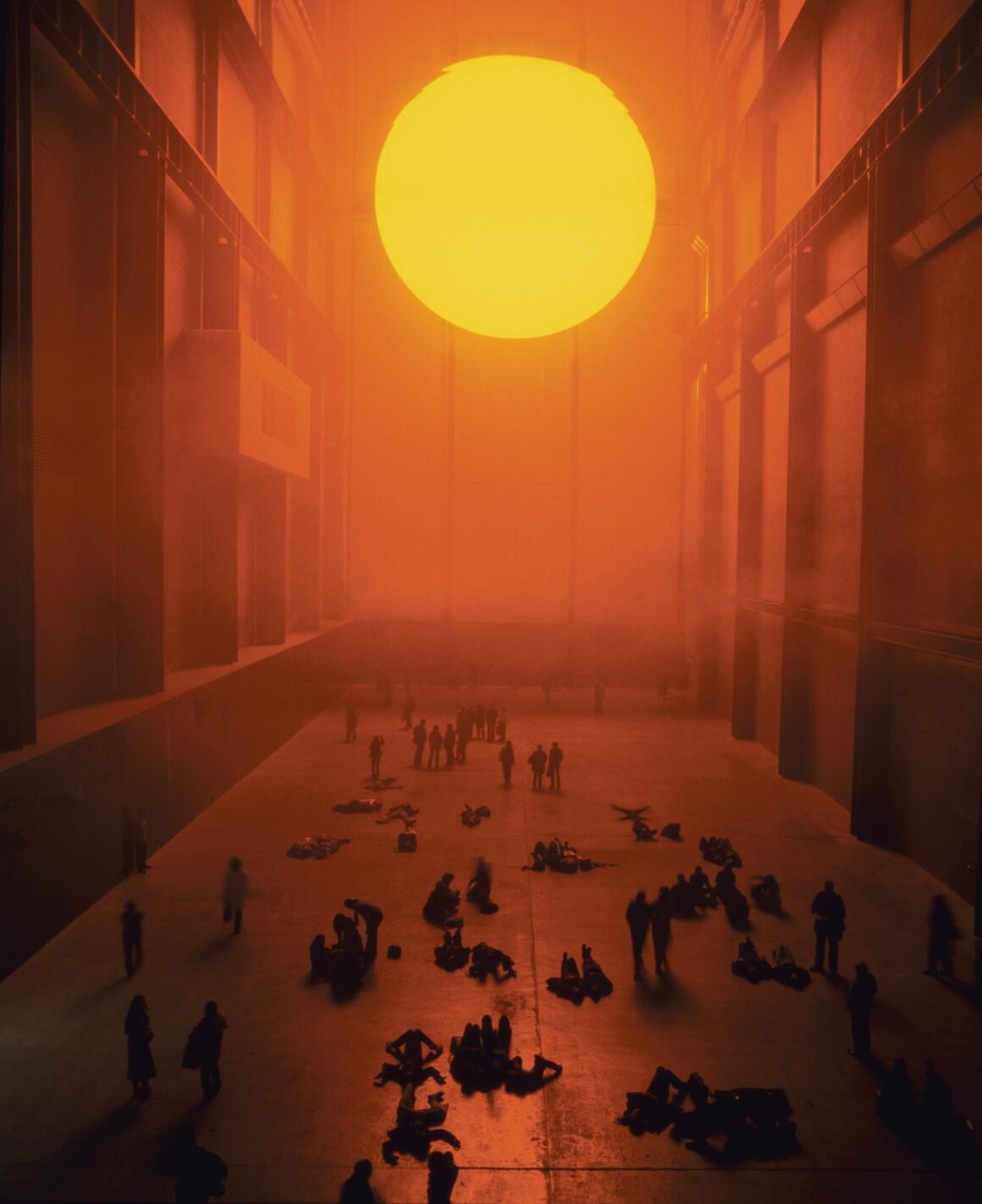
The Immersive Encounter
Imagine stepping into a vast, cavernous space, its atmosphere filled with a radiant golden haze. Above you, an immense artificial sun radiates warm, amber light, casting an ethereal glow across the room.
The light feels almost tangible, wrapping itself around you and blurring the line between the natural and the artificial. A fine mist lingers in the air, gently settling on your skin and carrying a faint, metallic scent—reminiscent of the moments after a summer storm.
Your gaze instinctively lifts to a mirrored ceiling, which doubles the sun and reflects the crowd below, creating an infinite, dreamlike panorama.
In this immersive environment, memories are stirred—childhood afternoons bathed in sunlight, endless sunsets on the horizon, and the vastness of open skies. Around it, visitors recline on the floor, captivated by the radiant atmosphere, as if immersed in a collective trance.
A quiet awareness emerges—we’re connected by a deeper meaning, sharing the same feelings, yet each experiencing it in a personal way.
The setting resonates with emotion, yet remains profoundly silent. Awe, nostalgia, and serenity intertwine, transforming the space into more than just a visual experience. —it becomes a portal that connects light, space, and atmosphere, provoking introspection and dialogue.
By the end of this journey, you leave not only moved, but with a deeper connection to the planet and a renewed sense of purpose, ready to embrace sustainability.
This remarkable experience was part of The Weather Project, created by the Danish-Icelandic artist Olafur Eliasson and displayed at Tate Modern’s Turbine Hall in London in 2003.
Drawing over 2 million visitors, this installation remains the museum’s most visited exhibition—a testament to its extraordinary resonance.
The Weather Project reminds leaders that linking sensory experiences to personal memories fosters empathy and creates an energizing force, helping to mobilize individuals and organizations. In sustainability, this emotional connection is particularly important for driving adoption and ensuring successful implementation.
The Spark of Sustainability
Long before sustainability became a central theme in Corporate Boardrooms, Olafur Eliasson was embedding its essence into his art.
Since the early 1990s, he has seamlessly integrated natural elements, such as light, water, color, and air—into interactive experiences that force us to confront our relationship with nature.
Eliasson´s large-scale installations transform abstract environmental challenges into tangible, sensory experiences that not only amplifies the visibility of issues like climate change but also awaken a personal sense of responsibility and drive for action.
Works such as Ice Watch (2014), where massive blocks of Greenlandic ice were displayed in urban settings, also serve as stark reminders of global warming.
By making the melting ice a visceral symbol of environmental degradation, Eliasson bridges the gap between awareness and action. His art is a powerful call to reflect on the planet’s fragility and to consider sustainable practices as essential responses to environmental challenges.
From Inspiration to Corporate Action
Eliasson´s influence transcends the art world, resonating with Business Leaders and policymakers alike.
Invited to high-profile events—such as corporate gatherings at LVMH hosted by CEO Bernard Arnault and global forums with figures like the President of Iceland—Eliasson confronts Leaders with a neglected lever for the success of sustainability strategies:
Real change happens when sustainability is not just framed as a strategic goal, a technical plan, or regulatory obligation but connected to people’s own lived experiences on an emotional and sensory level.
From Concept to Immersive Reality
At the heart of Eliasson’s work is his ability to transform bold concepts into immersive, multi-sensory experiences through crafted installations.
He has achieved this by blending diverse materials with expertise from fields outside the traditional art world, such as scientists, meteorologists, and programmers, redefining the artistic process and remind us that transformative solutions often emerge when varied perspectives and disciplines come together.
Closing Thoughts
As we have seen throughout this article, Eliasson’s work offers leaders several insights, but it’s worth highlighting one: when leaders guide individuals to perceive sustainability through the lens of their memories and sensations, this emotional connection becomes the strongest catalyst for change.
Without it, even the most groundbreaking innovations risk failing to engage people in a way that fosters lasting transformation.
* * *
Jose Taboada – Founder of Artcipation | Corporate Strategist
Key Sources: Olafur Eliasson´s website, Tate Modern
© 2025 Artcipation
Do you want to receive more information about this topic?
Subscribe our newsletter today!



Leave a Reply